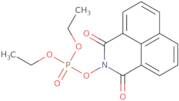Naftalofos
CAS: 1491-41-4
Ref. 3D-BAA49141
| 25mg | Discontinued | ||
| 50mg | Discontinued | ||
| 100mg | Discontinued | ||
| 250mg | Discontinued | ||
| 500mg | Discontinued |
Product Information
- 1,3-Dioxo-1H-benzo[de]isoquinolin-2(3H)-yl diethyl phosphate
- 1H-Benz[de]isoquinoline-1,3(2H)-dione, 2-[(diethoxyphosphinyl)oxy]-
- 2-[(diethoxyphosphoryl)oxy]-1H-benzo[de]isoquinoline-1,3(2H)-dione
- Bay 9002
- Bayer 9002
- Diethyl N-hydroxynaphthalimide phosphate
- Diethyl Naphthalene-1,8-Dicarboximidooxyphosphonate
- Ent 25567
- Maretin
- N-Hydroxynaphthalimide diethyl phosphate
- See more synonyms
- Naphthalimide, N-hydroxy-, diethyl phosphate
- Naphthalophos
- O,O-Diethyl N-hydroxynaphthalimide phosphate
- Phosphoric acid, 1,3-dioxo-1H-benz[de]isoquinolin-2(3H)-yl diethyl ester
- Phosphoric acid, N-hydroxynaphthalimide O,O-diethyl ester
- Rametin
- S 940
Naftalofos is a drug that has clinical relevance in the treatment of animal health. It is an anthelmintic that kills parasitic worms by inhibiting the enzyme ryanodine receptor, which regulates calcium release from the sarcoplasmic reticulum. Naftalofos has been shown to have a synergistic interaction with other anthelmintics, such as praziquantel and levamisole, when used in combination. The detoxification enzymes of these drugs are inhibited by Naftalofos, leading to toxicity in parasites. This drug also interacts with carbonyl groups found in proteins and nucleic acids. Structural analysis has revealed that Naftalofos binds to the c1-c6 region of the parasite's outer membrane protein and prevents ion flow across the membrane.





